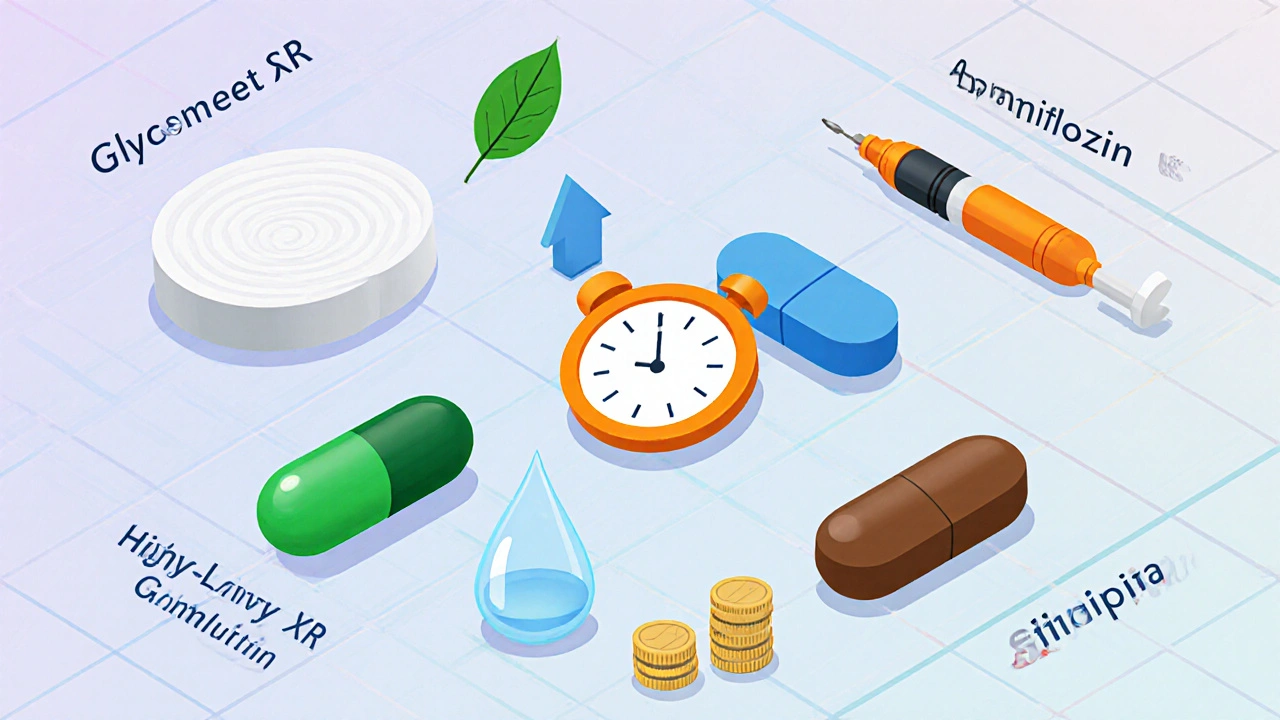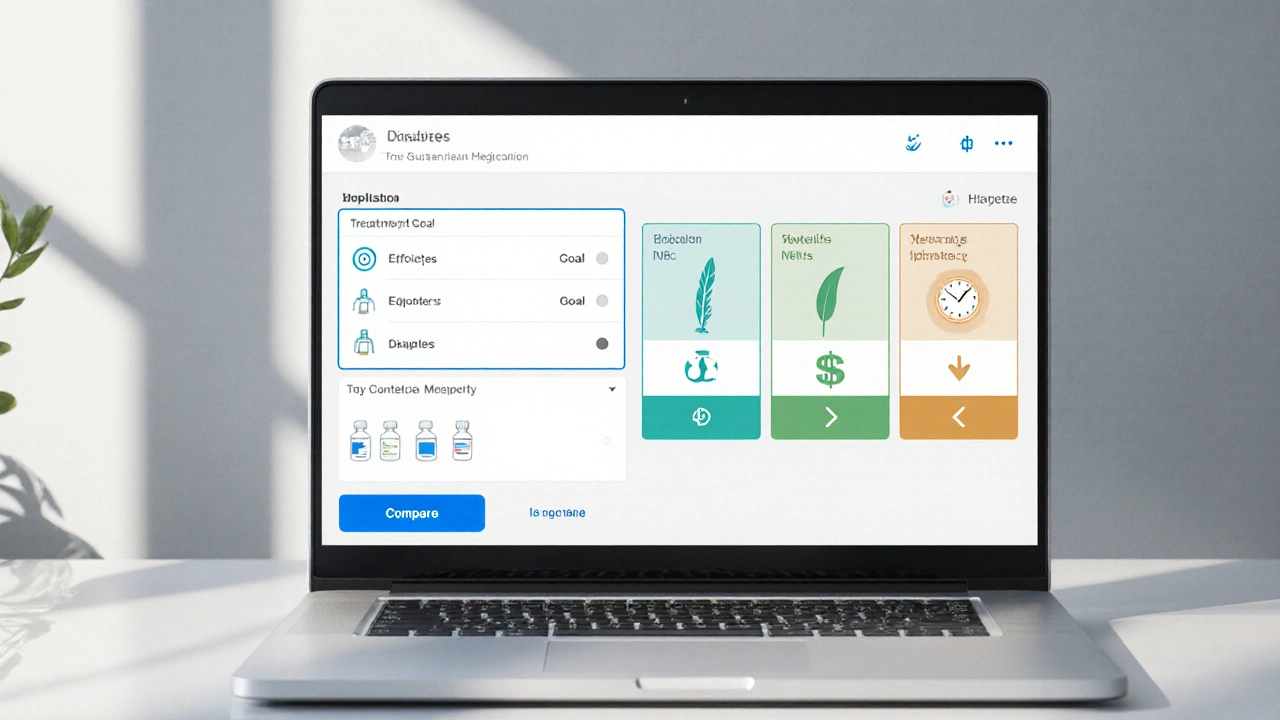Glycomet SR vs Alternatives Comparison Tool
Select medications and click "Compare" to see detailed information.
Key Attributes Summary
How much does the drug lower HbA1c?
- Glycomet SR: Moderate reduction
- Empagliflozin: Significant reduction
- Liraglutide: High reduction
- Sitagliptin: Minimal reduction
- Glimepiride: Moderate reduction
Once daily vs multiple times a day
- Glycomet SR: Once daily
- Glucophage XR: Once daily
- Empagliflozin: Once daily
- Liraglutide: Once daily (injectable)
- Sitagliptin: Once daily
- Glimepiride: Once daily
GI tolerance, risk of hypoglycemia, weight impact
- Glycomet SR: GI upset, rare lactic acidosis
- Empagliflozin: UTIs, genital infections
- Liraglutide: Nausea, vomiting
- Sitagliptin: Headache, nasopharyngitis
- Glimepiride: Hypoglycemia, weight gain
Trying to decide whether Glycomet SR is right for you? This guide compares the sustained‑release metformin with the most common alternatives, so you can pick the option that fits your lifestyle and health goals.
What is Glycomet SR?
Glycomet SR is a sustained‑release formulation of metformin (biguanide) that provides steady plasma levels over 24hours, allowing once‑daily dosing. It contains the same active ingredient as standard metformin tablets but is coated to dissolve slowly in the gut.
How does Metformin work?
Metformin is a biguanide oral hypoglycemic used as first‑line therapy for type2 diabetes. It lowers blood glucose by reducing hepatic gluconeogenesis, improving peripheral insulin sensitivity, and modestly decreasing intestinal glucose absorption.
Why consider a sustained‑release version?
The main advantage of a once‑daily tablet is convenience. Fewer doses mean better adherence for many patients. The extended‑release matrix also spreads the drug’s exposure, which can lessen the notorious gastrointestinal (GI) upset that affects up to 30% of people on immediate‑release metformin.
Key criteria to compare medications
- Efficacy: How much does the drug lower HbA1c?
- Dosing frequency: Once daily vs multiple times a day.
- Side‑effect profile: GI tolerance, risk of hypoglycemia, weight impact.
- Renal safety: Suitability for patients with reduced kidney function.
- Cost in Australia: Brand price vs generic equivalents.
- Weight effects: Some drugs cause weight gain, others promote loss.
Popular alternatives to Glycomet SR
Glucophage XR is another sustained‑release metformin product, marketed by a different manufacturer. It shares the same dosage options (500mg, 750mg, 1000mg) but may have slightly different release kinetics.
Empagliflozin is an SGLT2 inhibitor that lowers glucose by increasing urinary excretion. It is taken once daily and also offers cardiovascular and renal protection.
Liraglutide is a GLP‑1 receptor agonist administered by subcutaneous injection (once daily). It reduces HbA1c, promotes weight loss, and carries a low hypoglycemia risk.
Sitagliptin belongs to the DPP‑4 inhibitor class. It’s taken once daily, has a modest HbA1c reduction, and is weight‑neutral.
Glimepiride is a sulfonylurea that stimulates insulin secretion. It is inexpensive but carries a higher risk of hypoglycemia and weight gain.
Type 2 Diabetes is a chronic metabolic disorder characterised by insulin resistance and relative insulin deficiency. Management typically involves lifestyle changes plus pharmacotherapy.

Side‑by‑side comparison table
| Medication | Release Form | Typical Daily Dose | Frequency | Approx. Cost (AU$) per month* | Common Side Effects | Renal Suitability |
|---|---|---|---|---|---|---|
| Glycomet SR | Sustained‑release tablet | 500-2000mg | Once daily | ~$30 (brand) / $8 (generic equivalent) | GI upset (nausea, diarrhoea), lactic acidosis (rare) | eGFR ≥45mL/min/1.73m² (cautious down to 30) |
| Glucophage XR | Sustained‑release tablet | 500-2000mg | Once daily | ~$28 (brand) / $7 (generic) | Similar GI profile to Glycomet SR | Same eGFR thresholds |
| Empagliflozin | Immediate‑release tablet | 10-25mg | Once daily | ~$70 | UTI, genital mycoses, volume depletion | eGFR ≥30mL/min/1.73m² (label‑recommended) |
| Liraglutide | Injectable solution | 1.2-1.8mg (sub‑Q) | Once daily | ~$150 | Nausea, vomiting, pancreatitis (rare) | eGFR ≥45mL/min/1.73m² (dose adjustment above) |
| Sitagliptin | Immediate‑release tablet | 100mg | Once daily | ~$45 | Headache, nasopharyngitis, rare pancreatitis | eGFR ≥30mL/min/1.73m² (no dose change) |
| Glimepiride | Immediate‑release tablet | 1-8mg | Once daily | ~$12 | Hypoglycaemia, weight gain | Use with caution if eGFR <60; monitor closely |
*Prices are 2025 Australian retail averages and can vary with pharmacy discounts or PBS coverage.
Who benefits most from Glycomet SR?
- Patients who struggle with remembering multiple doses per day.
- Those who experience GI irritation on immediate‑release metformin but tolerate the slower absorption.
- Individuals with modest renal impairment (eGFR 45‑60) who still want the cost advantage of metformin.
- People aiming for weight neutrality-metformin generally does not cause weight gain.
When might an alternative be a better fit?
- Severe GI intolerance: Switching to an SGLT2 inhibitor like empagliflozin can bypass the gut entirely.
- Need for weight loss: GLP‑1 agonists (liraglutide) actively promote appetite reduction.
- Cardiovascular risk: Empagliflozin and liraglutide have proven heart‑failure benefits.
- Low budget constraints: Sulfonylureas (glimepiride) are the cheapest oral agents, though they raise hypoglycaemia risk.
- Renal function <30mL/min/1.73m²: Most metformin products are contraindicated; SGLT2 inhibitors (with adjusted dose) or insulin become necessary.
Practical tips for starting or switching
- Assess kidney function - get a recent eGFR before prescribing any metformin.
- If moving from immediate‑release to Glycomet SR, divide the total daily dose into a single SR tablet; avoid overlapping the two forms.
- Take the SR tablet with the evening meal to minimise nocturnal nausea.
- Monitor blood glucose daily for the first two weeks; adjust dose by 500mg increments if HbA1c target isn’t reached.
- Educate patients on signs of lactic acidosis (muscle pain, rapid breathing) - rare but serious.
- When switching to a non‑metformin class, consider a short overlap period to avoid loss of glycaemic control.
Bottom line
Glycomet SR offers the proven efficacy of metformin with the convenience of once‑daily dosing and a slightly gentler GI profile. It shines for people who value simplicity and cost‑effectiveness. However, newer drug classes bring added benefits - heart protection, weight loss, and renal safety - that metformin can’t match. The right choice hinges on your personal health goals, kidney health, and budget.
Frequently Asked Questions
Can I take Glycomet SR if I have a mild kidney problem?
Yes, if your eGFR is 45mL/min/1.73m² or higher you can use Glycomet SR, but the dose may need to be reduced. Below 30mL/min the drug is generally avoided because of lactic acidosis risk.
How does the efficacy of Glycomet SR compare to immediate‑release metformin?
Clinical trials show virtually identical HbA1c reduction - about 1.0‑1.5% on average - when the total daily dose is the same. The main difference is the side‑effect profile and dosing convenience.
Is Glycomet SR covered by the Australian PBS?
Yes, the PBS lists metformin SR formulations under the generic name metformin. You’ll need a prescription from a GP or endocrinologist to claim the subsidised price.
What should I do if I experience diarrhea on Glycomet SR?
Start with the lowest dose (500mg) and increase gradually every 1‑2 weeks. Taking the tablet with a substantial evening meal helps. If symptoms persist, discuss switching to another metformin brand or an alternative drug class with your doctor.
Are there any drug‑food interactions I should know about?
Avoid taking Glycomet SR with excessive alcohol, as both can increase the risk of lactic acidosis. Also, high‑fiber meals can slightly delay absorption, but this doesn’t affect overall efficacy.

Tiffany Clarke
Glycomet SR feels like a sigh of hope for folks fed up with GI drama
Sandy Gold
The prevailing dogma posits that sustained‑release metformin is the optimal first‑line therapy for the majority of type 2 diabetics.
Yet, a cursory glance at the literature reveals a plethora of methodological flaws that undermine this assertion.
Many of the cited trials suffer from under‑powered sample sizes, rendering their conclusions statistically tenuous.
Moreover, the commercial bias introduced by pharmaceutical sponsorship cannot be dismissed lightly.
It is also worth noting that the incremental HbA1c reduction offered by Glycomet SR over its immediate‑release counterpart is clinically negligible.
Patients frequently report persistent gastrointestinal distress despite the purportedly gentler release kinetics.
The cost differential, although modest on paper, becomes significant when factoring in the long‑term economic burden on the healthcare system.
In contrast, agents such as empagliflozin and liraglutide provide demonstrable cardiovascular benefits that extend beyond mere glycemic control.
The side‑effect profiles of these newer classes, while not devoid of issues, are generally more tolerable for the average patient.
It is bewildering that guidelines continue to elevate metformin to a near‑canonical status without adequately addressing these nuances.
Furthermore, the renal dosing thresholds for metformin remain a contentious topic among nephrologists.
The blanket recommendation to reduce dosage at eGFR <45 mL/min/1.73 m² fails to account for individual variability in drug clearance.
A more personalized approach, incorporating pharmacogenomic data, would likely yield superior outcomes.
Nonetheless, the inertia of clinical practice perpetuates the use of metformin as a one‑size‑fits‑all solution.
In summary, clinicians should critically appraise the evidentiary base before defaulting to Glycomet SR as the default option.
Frank Pennetti
The pharmacokinetic profile of sustained‑release metformin exhibits a blunted Cmax, mitigating lactic acidogenesis while preserving insulin sensitization across hepatic gluconeogenesis pathways, thus offering a salutary adjunct to the therapeutic armamentarium.
Adam Baxter
Switch to Glycomet SR and own your diabetes journey
Keri Henderson
Stick with the once‑daily regimen, it simplifies adherence and keeps your A1c in check – you’ve got this!
elvin casimir
While Glycomet SR’s GI profile is “better”, the phrasing is inconsistent – it should read “better” without quotes, and the cost analysis lacks granular breakdown.
Steve Batancs
From a domestic healthcare perspective, the cost‑effectiveness of generic metformin formulations such as Glycomet SR underscores the importance of supporting American‑based pharmaceutical production.
Ragha Vema
What if the “once‑daily” claim is just a marketing ploy to keep us compliant while the pharma giants harvest data from our glucose meters?
Scott Mcquain
One must acknowledge the moral imperative of prescribing drugs with minimal hypoglycemia risk; any deviation borders on negligence, especially when alternatives exist.
kuldeep singh sandhu
Actually, the efficacy of Glycomet SR is overstated; numerous studies show marginal HbA1c reduction compared to lifestyle modifications alone.
Mariah Dietzler
i think the article misses the point about real world adherence problems, people dont stick to pills anyway
Nicola Strand
Contrary to popular belief, the cardiovascular benefits attributed to SGLT2 inhibitors do not necessarily translate to superior outcomes when combined with metformin.
Jackie Zheng
Indeed, while the data suggest additive effects, the statistical significance often hinges on subgroup analyses that may suffer from multiplicity bias.
Hariom Godhani
Let us not forget that the saga of metformin is not merely a tale of biochemical inhibition but a chronicle of geopolitical maneuvering, where multinational conglomerates dictate therapeutic orthodoxy.
The historical rollout of sustained‑release formulations was championed by lobbying corridors rather than pure scientific zeal.
Patients, meanwhile, are left to navigate a labyrinth of dosage adjustments, renal monitoring, and insurance formularies.
Even the purported convenience of once‑daily dosing masks the reality of titration schedules that can span weeks.
Moreover, the lingering specter of lactic acidosis, however rare, continues to haunt clinicians who must weigh risk versus benefit in vulnerable populations.
When juxtaposed with newer agents offering weight loss and cardiovascular protection, metformin’s modest HbA1c impact appears almost antiquated.
Yet, the inertia of clinical guidelines keeps it entrenched, a relic sustained by cost‑containment imperatives rather than patient‑centred outcomes.
In the end, an informed prescriber must dissect these layers before defaulting to Glycomet SR as the silver bullet.
Jackie Berry
As a cultural observer, I notice the narrative surrounding metformin is steeped in Western medical hegemony, eclipsing traditional approaches.
Mikayla May
If you’re considering Glycomet SR, start with a low dose to gauge GI tolerance, then titrate up to the target 1500 mg daily, monitoring renal function quarterly.
Jimmy the Exploder
meh this advice is boring and overused, same old tip
Robert Jackson
While your dismissal is noted, the prescriptive guidance remains evidence‑based and indispensable for safe titration of metformin therapy.